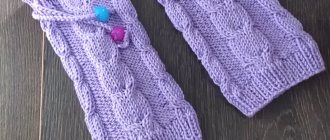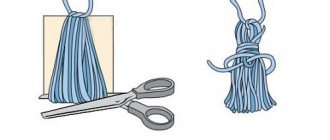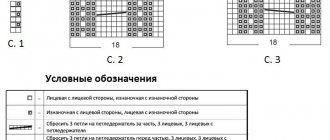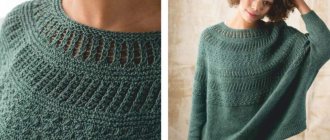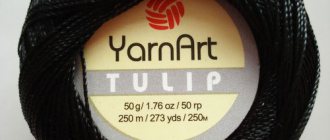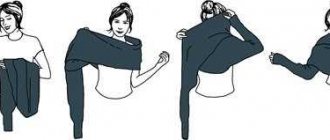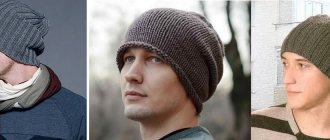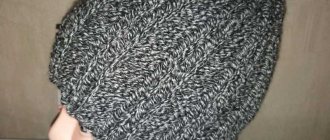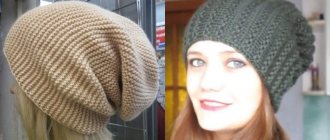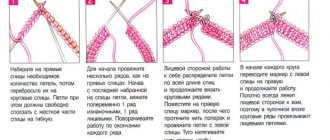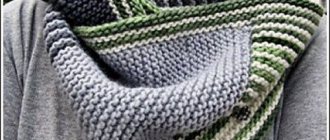Types of men's sweaters: review, patterns, photos
Before you start knitting, you should decide on the model of the sweater and how you will knit it. We will give the most popular types and some explanations for them.
- Men's raglan sweater knitted from top to bottom. Most often knitted seamlessly, depending on the wishes of the man, the model is equipped with a high turn-down collar or a round neck;
- Men's raglan sweater knitted from bottom to top. It is also most often knitted in the round in a seamless manner, but sometimes knitters prefer to knit the back and face separately;
- A men's sweater with set-in sleeves is one of the most popular models among men, and therefore knitters. Knitted from the bottom up, either whole or divided into a back and front part;
- Men's sweater with dropped armhole. A popular baggy model, which is chosen not only by young people, but also by respectable men. Unlike previous options, it is ideal for beginners, as it does not require complex manipulations.
Having decided on the model, we recommend, although not in full size, to draw yourself a schematic pattern so that you visually understand what you are knitting. It is especially important for beginners who knit from a video, since there is a risk of simply repeating the manipulations after the video lesson and not understanding what you are doing, and therefore, if an error occurs, you will never find it. And it will appear at the time of assembly or fitting, which will definitely upset you.
- Schematic pattern of a men's raglan sweater. Please note that the back and front of the product match completely, except for the neck. Raglan sleeves are always knitted the same way.
Schematic pattern of a men's raglan sweater
- Schematic pattern of a men's sweater with set-in sleeves. Don’t be intimidated by the complexity of the pattern, since for the first time you will probably knit according to the master class, and accordingly all the increases will be given, but you will already be doing them consciously.
Schematic pattern of a men's sweater with set-in sleeves
- Schematic pattern of a men's sweater with a dropped armhole . This pattern tends to look baggy and cozy, ideal for chunky knits and fluffy yarns like angora and mohair. As you can see from the diagram, this is an excellent solution for a beginner, since there are no complex additions or reductions, calculations or any difficulties in general.
Schematic pattern of a men's sweater with a dropped armhole
Warm yarn and knitting needles
For a men's winter sweater, it is better to choose a thicker thread. This way the canvas will look stronger and warmer. But the strength of the thread is not only in the thickness, it must also contain a lot of wool. Because it is wool that makes the yarn warmer. Some models are best done with double thread.
For a man, you can also use some types of barbed threads, since the sweater is usually not worn on a naked body. But if you have very sensitive skin, you shouldn’t risk it, otherwise the product will simply lie in the closet.
Important! For sensitive skin, you should choose hypoallergenic formulations.
The knitting needles for knitting a raglan sweater are circular knitting needles. Since the product will be made in a circle.
Circular knitting needles
Stocking needles will not cope with it, since there will be a lot of loops and there simply will not be enough of them for the job. It is very important that the knitting needles match the number. Each thread thickness has its own knitting needle number. This hint is usually on the yarn packaging.
Choosing a pattern for a men's sweater with knitting needles: diagram with description
For beginners, it is best to choose simple patterns, but more experienced craftswomen will most likely want complex patterns, braids and fashionable arans. It is worth remembering that different patterns lie differently depending on the chosen yarn, and also the golden rule - the fluffier the yarn, the simpler the pattern, since complex patterns will simply be lost in the fibers.
Next, we cast on 20-25 loops and knit a pattern; if the pattern is larger, we cast on more loops; if there are several patterns, we cast on so that all the patterns are on the sample. We knit 10 cm, close the loops, wash and dry the sample, and only after that we measure and calculate the number of loops for the product.
Important: in addition to the volume of the chest, arms and waist, it is necessary to add an allowance for a loose fit:
- Tight-fitting sweater - 0 cm;
- Sweater according to the figure - 1-3 cm;
- Loose sweater - 4-5 cm.
And in conclusion to this point, we present a fashionable pattern of arans for men's sweaters.
Fashionable aranami pattern in Scandinavian style
Arana knitting for men's sweaters - diagram
Intricate diamond patterns for men's sweaters: pattern and diagram
What needs to be prepared - tools, materials
Preparation for needlework is a necessary component for a quick and comfortable process. The first stage is choosing a model and style. Next is the selection of a diagram that is understandable and easy to read. Traditionally, it indicates the type of yarn needed, but sometimes it can be replaced with another.
Threads of natural and synthetic origin are available on the market:
- Sheep's wool . Warm, resistant to getting wet, friction can cause pellets to form.
- Merino . Ideally retains heat, very light, and has a high price.
- Alpaca . Resistant to pulling, does not pellet. Depending on the density of knitting, both thick warm sweaters and light pullovers can be created.
- Mohair is a fiber obtained from the down of Angora goats. Very warm, but items made from this yarn require careful care.
- Cashmere – skeins of yarn end up on the market mixed with other types of wool due to cashmere’s high susceptibility to external factors.
- Angora - balls contain about 40% of this wool, it is soft and airy.
- Acrylic is a synthetic fiber, similar in quality to natural wool. Resistant to friction, durable, lightweight.
The next stage is preparing the necessary knitting needles. The required number is also indicated in the diagram.
Following actions:
- take accurate measurements so that the sweater fits your figure;
- knit a sample - this will allow you to determine the density of the knitting and the pattern of the pattern.
The best elastic band for knitting a men's sweater: diagram with description
A men's sweater is a very voluminous product, knitting it will take from 5 days to several months, depending on the complexity of the product and your speed. Therefore, it is worth choosing high-quality yarn, making loop calculations only after WHT (wet heat treatment), and also paying due attention to detail so that the product can be worn for a long time and with pleasure.
As you know, the elastic is the place that stretches and thereby spoils the appearance of the product in the first place. We suggest abandoning regular or English elastic bands for cuffs in favor of a non-stretchable elastic band that can be knitted either 1x1 or 2x2. For experienced knitters, we provide a diagram and a simple description, and for beginners, video tutorials.
Scheme of double non-stretch elastic band
So, everything is simple, knit a 1x1 elastic band in the first two rows as usual (front and back), from the 3rd row: the front loop is removed, the thread behind the knitting, the wrong one is knitted, and so on until the end of the row, repeat the report. Wrong side - the elastic band is knitted as usual.
In the same way you can knit: the first row is 1x1, from the second row: the front loop is knitted as usual, the wrong side is removed, thread before knitting. Both methods are correct, knitting is equally simple, but the yarn consumption increases by 30%, due to broaches that prevent the cuff from stretching.
A simple model for beginners
Experts recommend that beginners choose a simple option with a wide elastic band for their first experience. The result will be a regular everyday sweater, so the color of the yarn should be neutral. The suggested product size is 48/50. It is recommended to buy yarn made from sheep wool and free from impurities, weighing 650 g.
You will need 2 types of knitting needles:
- straight;
- circular at number 5.
The principle of knitting the pattern: first perform 4 knit stitches, then 2 purl stitches.
The work is divided into 4 stages:
- Making the back.
- Front knitting.
- Sleeves.
- Assembly of the finished product.
The first row of the back consists of 90 loops.
Knitting principle:
- The first loop is always an edge loop.
- The next one is a purl one.
- 14 repetitions of loops of the main pattern.
- Purl loop.
- Completion - edge.
It is necessary to knit 98 rows in this way. Next you need to prepare the armholes. To do this, you need to close 2 loops and perform a similar action in each subsequent 2 row. When 46 rows with armholes are ready, you need to do the shoulder bevel, casting off 6 loops. At the same time, close 32 central loops for the neck. Subsequent rows on the sides are knitted separately.
For rounding, then close 1 loop at a time, doing this in the second rows. The last one should have 7 loops left. The second part needs to be completed by mirroring. The front should be knitted according to the same pattern. The only difference is the deeper neck. To knit it, you need to close the central 26 loops on the 38th row of armholes. The rest of the steps are similar.
The first row of the sleeve is done in the same way as the front and back. The difference is that you only need to repeat the main pattern 6 times. To make bevels, you need to add 1 loop to every 6 rows. On the 104th row from the initial one, 2 loops are closed for okat. In each subsequent row, purely loops are reduced. They should be closed when 14 remain.
Before assembling, you need to wet each one, pin it to the pattern and wait until it dries.
Next you need to make the shoulder seams. Using circular knitting needles, cast on 74 stitches along the edge of the neckline and knit 44 rows. Sew the product on the sides, then carry out the same actions with the sleeves and attach them to the finished knitted product.
Closing the loops on a men's sweater - elastic edge
Another secret to the perfect men's sweater is the elastic closure of the loops. A really important factor, which, on the one hand, makes it possible to produce uniquely designed items; on the other hand, for fans of factory-made products (largely due to the experience of wearing low-quality products), an elastic product quickly returns to its original shape.
To elastically close the elastic (we are only disassembling the elastic, since this is what is on the cuffs of men's sweaters) you will need a needle with a wide eye and a blunt point. They come in metal and plastic and are sold in craft stores, fabric stores, etc.
Hooded
The presence of a hood is a youth trend.
To knit a sweater like this you will need:
- sheep wool yarn – 1100 g;
- knitting needles No. 5;
- circular knitting needles 40 cm long - No. 4.
The work uses:
- Rubber.
- Smooth surface.
Back: after casting 100 loops, knit 7 cm with an elastic band. The neck is closed through 148 rows - the central 20 loops. To round the collar, close 2 loops twice in every second row. After 156 rows, 33 shoulder loops are closed. The front is knitted in the same way; for the neck, 12 loops are closed in 139 rows. Next - 4 times 2 loops in each row and 4 times - 1 loop.
The cuff is knitted on 44 loops with an elastic band. Height – 6 cm. In each 6th row, add 1 loop 17 times. Close after 108 rows.
To make the hood, you need to sew the sweater parts in the shoulder area and cast on 137 stitches along the edge of the neckline on round knitting needles.
Landmarks - start 8 cm from the center of the front part, end also 8 cm. Knit 46 rows.
Cast off 44 outer loops and work with 49 central ones. You should get a total of 110 rows.
For assembly you must use round knitting needles.
Having collected 95 loops, they begin to knit using the “elastic” pattern. It is necessary to provide a drawstring where the cord is inserted. Sew the details of the sweater.
Assembling a men's sweater
The ideal solution, of course, is seamless models. In other cases, assembly of the product is required. And here lies another secret. Many craftswomen recommend initially carrying out a WTO of parts, and only then assembling them. Please note that knitwear, even when hand washed, drained in a net (instead of wrung out) and dried horizontally, may change slightly in size. And if this is really insignificant when worn, but when sewing it can become a very big problem. Therefore, we recommend that you first assemble the product, and only then wash and dry it as described above.
With braids
The “braid” pattern is used in various models of men’s sweaters, adding elegance to the finished item.
The simplest braid pattern is knitted according to the following pattern:
- It is necessary to knit the initial row - the loops alternate in groups of 3. Finish with purl stitches.
- In each even row, you should take into account the correspondence of the type of loops below and repeat them.
- Row 3 – purl 3, knit 3, remove 3, purl 3, return removed ones, complete with purls.
- Similarly to the first one, you need to knit rows No. 5 and 9.
- In the 7th row, the angle of inclination changes - 3 loops are removed, the same number of knit stitches are knitted, the removed loops are knitted purlwise, the knit stitches are repeated.
Starting from the tenth row, the pattern in the form of braids must be repeated.
How to knit a men's sweater with a set-in sleeve: diagram with description
As we said earlier, a men's sweater with set-in sleeves is one of the most popular models and does not go out of fashion from season to season. For the first time, we recommend knitting a sweater according to the master class, and after you understand the nuances in constructing the details, you can knit any sweater of your choice according to your sketches.
Scheme of a men's sweater with a set-in lowered sleeve
Knitting a men's sweater with a dropped armhole is quite simple:
- We knit a sample, perform a WTO, calculate the loops;
- We collect an elastic band from below (can be on the back and front, or by circular knitting);
- We knit an elastic band of 5-7 cm as desired and move on to the main pattern;
- We knit exactly to the beginning of the neckline and begin to close from the middle according to the pattern, closing the shoulders evenly. If you are knitting in the round, go to the armhole (17-24 cm depending on the size and fullness of the sweater) and bind off 3 loops under your arms and then knit the front and back separately from each other;
Round neck pattern for a men's sweater
- Sew the shoulders and knit the neckline;
- We knit the sleeves from the bottom up, close them evenly and sew them on; you can also pick up the sleeves at the armhole and knit down to the cuff.
How to calculate raglan top with sprout for men's pullover
4.3
(31)
Approximate time to read the article: 4 minutes
To knit any products with raglan on top, it is necessary to calculate the raglan loops and the sprout. Raglan knitting is a one-piece product in which the front, back and 2 sleeves are knitted at the same time. To ensure that the product fits well on the figure, a sprout is knitted. If we look at a knitted product, for example a pullover, we will see that the back neckline is located slightly higher than the front neckline. This difference is the germ.
I propose to calculate step by step the raglan top with sprout for a men's pullover and then knit it. Pullover size 48-50, head circumference is 58 cm.
To work you will need:
- The yarn, in my example, is Turkish-made Kartopu Deluxe yarn. 75% acrylic and 25% wool, 100g 200m.
- Circular knitting needles No. 3.5mm
- Circular knitting needles No. 2.5 mm
- Markers
Work plan:
- Calculation of loops for the neck,
- Knitting elastic
- Knitting a false kettle
- Calculation of loops for a sprout
- Calculation of loops for the neck
You need to knit a sample from yarn, you need to cast on 25-30 loops and knit with stockinette stitch about 11-12 cm in height. To determine the knitting density, measure the sample with a meter.
In 10 cm you need to count how many loops, in my case - 19. Thus, in 1 cm = 19/10, we get 1.9 loops.
Head circumference - 58 cm, 58×1.9 = 110.2 loops. Round up, we get 110 loops needed to knit the neckline.
Calculation of knitting density
The next stage, the distribution of raglan loops, look at the picture.
Raglan calculation scheme
2. Knitting an elastic band:
Then, cast on 110 loops for the elastic band on circular knitting needles No. 3.5 mm. We knit an elastic band in a circle of 3.5 cm.
Set of loops
Knitting elastic
3. Knitting a false kettle.
The kettle is knitted so that the neck does not stretch out and has a beautiful appearance.
There are 110 loops on the knitting needles, now this figure should double. We knit on needles No. 2.5 mm.
- 1 row - yarn over, knit 1, knit to the end of the row
- 2nd row - we knit the yarn over with a crossed purl stitch, remove the knit one, the thread before work - before the purl stitch) we can say that the thread runs in the center, then we repeat
- 3rd row - remove the purl side, thread before work, knit the front one
- 4th row - we knit the purl one, remove the front one, thread before work
- 5th row - like 3rd row
- 6th row - like 4th row
- Row 7 - purl 2 stitches together until the end of the row. There should be 110 stitches left on the needles
Beginning knitting a false loop
Completed false loop
4. Calculation of sprout loops
We measure the sample in height. 10 cm - 24 rows.
1 cm = 24/10 = 2.4 rows knitting density. The height of the sprout can be different, in children's products 1-1.5 cm, adults 3-4 cm, on stooped figures - 4-5, and special figures up to 7 cm. Let's take 3 cm for a pullover.
3*2.4 (row knitting density) = 7.2 rows, rounded to 8 cm. The sprout consists of 8 rotating rows.
Distribution of increases across sleeves. 8/2 (sleeves) = 4, we get 4 groups of increases.
Calculation of knitting density
Sprout pattern and distribution of loops.
Scheme for calculating and distributing loops along the neck
Thus, we calculated the raglan loops on top with the sprout, knitted an elastic band, and a false kettle. We calculated the sprout. Next, you need to include the selected pattern in the knitting process, distribute it along the back and, as you work, gradually include the pattern in the front.
In the previous picture you can see that each sleeve is divided into 4 parts. This means that you need to knit sequentially; when you knit to the first mark, we go back to the second (turning rows). Visible holes (holes) appear at the turning point; you need to knit in this place so that this does not happen. This way the fabric on the back will be longer than on the front of the jumper.
Work process
This creates a beautiful neckline. This way the look and fit of the product on the figure will be correct.
When all the turns are connected, continue knitting on circular knitting needles, while making increases in the raglan line in compliance with the chosen pattern.
Neck with sprout
the process of working on raglan in a product
knitted fabric
This calculation for a men's half-over with a raglan top can be made for any size from children's, teenage, youth and adult. Knit the right and beautiful pullovers for your men. In the next article, using this jumper as an example, a lesson will be shown on how to design the armhole of the sleeve, knitting the sleeves themselves and the whole product until it is completely ready. At the following link you can see how to knit a men's raglan pullover on top with knitting needles for size 56-58.
Thank you for reading this article. I am sure that this article will be useful to many. Share on social networks with your friends. Subscribe to the VKontakte group.
How useful is the publication?
Click on a star to rate!
Average rating 4.3 / 5. Number of ratings: 31
No ratings yet. Be the first to rate.
Similar articles
Men's raglan top pullover with knitting needles How to knit a raglan top with knitting needles for a blouse for a girl 4-5 years old Cardigan crocheted from top to bottom Crochet blouse for a girl raglan, height 100-110 cm
Knitting patterns for stylish and fashionable men's sweaters with descriptions
- Men's sweater with raglan sleeves.
Men's sweater with raglan sleeves
- Men's sweater with thick threads.
Men's sweater with thick threads
- Men's sweater with rhombuses.
Men's diamond sweater
- Men's sweater with a plait pattern.
Men's sweater with a plait pattern.
Men's sweater with one-piece sleeves.
Men's full sleeve sweater
- Men's sweater with raised stripes.
Men's sweater with embossed stripes
- Men's sweater with aran pattern.
Men's Aran Sweater
- Men's sweater with hood.
Men's sweater with hood
- Men's Diamond Sweater.
Men's Diamond Sweater
- Men's sweater with longitudinal stripes.
Men's sweater with longitudinal stripes
- Men's sweater for dad and son.
Men's sweater for dad and son
Men's sweater with a relief pattern .
Men's sweater with embossed pattern
- Beautiful men's sweater with braids.
Beautiful men's sweater with braids
- Men's sweater with shawl collar.
Men's sweater with shawl collar
- Men's sweater with diamond pattern.
Men's sweater with diamond pattern
- Men's one-piece knitted sweater.
Seamless from top to bottom
Most often, an Irish pullover is knitted in a similar way, the distinctive detail of which is wide shoulder straps that hide the shoulder seam. According to the rules, seamless knitting starts from the neckline, which is done with circular knitting needles with an elastic pattern.
A pattern for such a model is not required, but frequent fittings are necessary to be able to quickly correct any defects that may arise.
After the neck is ready, it’s time to knit the shoulder straps, for which half of the loops on the sides are used, the rest are secured with pins. The traditional pattern for this part of the sweater is braids.
The next stage is knitting the back and front separately while the armhole is knitted. Next, circular knitting needles are used to finish the product. Aerobatics is the absence of seams on the sleeves, so for their manufacture loops of shoulder straps, front and back are used.
Choosing yarn for knitting
Each model in our selection is provided with a detailed description, which indicates the type of yarn and its quantity. If you cannot find the yarn indicated in the description, then you need to adhere to the following rules:
- it is necessary to select the thickness of the thread mentioned in the description. A difference of + 20 meters is allowed;
- It is better to choose yarn for knitting a pullover with an admixture of acrylic or alpaca. The product will be soft and will fit pleasantly to the body.
It is also necessary to adhere to the thickness of the knitting needles indicated in the description. The size of the product can be reduced or increased by creating a life-size pattern. After this, the number of pattern reports is calculated.
When purchasing yarn, it is better to take one or two skeins more. Then there will definitely be enough for the product, and the leftovers can be used to create other useful items.
A men's pullover knitted with knitting needles will be an excellent gift, appropriate for any occasion. There are many models presented on our website. It is very easy to knit the sweater you like, because each model comes with easy-to-understand patterns. Just choose the right model and start creating an exclusive item that will warm your loved ones in cold weather.
With a pattern of slipped loops
Patterns with removed loops create an openwork effect and are considered a feminine ornament. However, it is also possible to choose a stylish and discreet option for a men’s sweater to create a product in a “casual” style.
Experienced knitters recommend using a pattern for men's products that is knitted in the following way:
- You will need 2 colors.
- You need to knit 14 rows.
- Rows 1, 2 and 9-14 require a primary color, rows 3-8 require an auxiliary color.
- For odd rows, you need to make 10 loops, called knit stitches.
- Even - the same number of purls.
- Starting from the third row, add removed loops.
- 3rd row – remove 2-5 loops.
- Shift 1 to the left so that a diagonal is obtained.
- Having started knitting the 9th row, move to the right, the removed loops are similar to the 3rd row.
To repeat the pattern, use repeat from rows 3 to 14.
Variety of patterns
Men's pullovers knitted with knitting needles amaze with their variety of patterns. Even a sweater knitted with a simple pattern will look original and unusual if it is made from melange or fancy yarn. The most popular patterns for knitting men's pullovers are:
- English gum;
- braids and aranas;
- alternating knit and purl stitches;
- stocking and garter stitches;
- ornaments made using the jacquard method.
Knitters will find these and other patterns for knitting a men's pullover on our website. Each of them will make a pullover model for their loved one, based on their own knitting skills.
